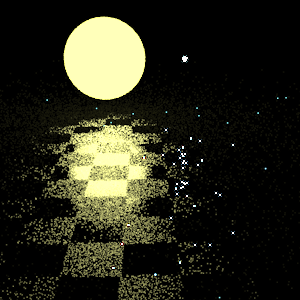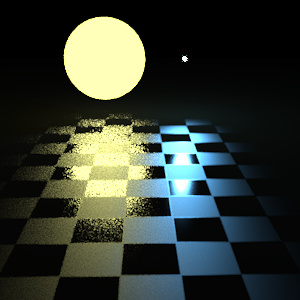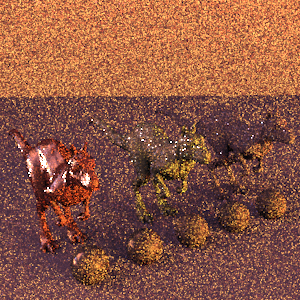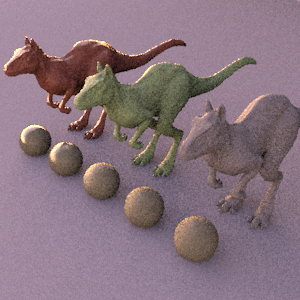Assignment 4
Part 2
Question 1
asdf
Part 3
BSDF-only Sampling |
Light-only Sampling |
Multi-Importance Sampling |
|
|
|
Question 2
There is less noise in regions of the floor where the specular highlight is very likely to reflect the yellow light source. Since the yellow light source is very large, in the area of floor where specular rays tend to reflect towards the yellow light, these rays are quite likely to intersect the yellow light. It's reflection is therefore consistently visible and noise is low.
The area of the floor whose specular highlight is very likely to reflect the blue light, however, has severe noise. Because the blue light is very small, few rays which reflect towards it actually intersect it and the blue light's reflection appears in few samples.
WHY THE RANDOM WHITE PIXELS???
Question 3
When sampling only the light source in this scene, the worst case noise from the bsdf-only render becomes the best case and the best case from the bsdf-only render becomes the worst case.
The blue light's reflection, which formerly appeared as sparse noise, looks nearly perfect. Since the light is quite physically small, consecutive sample rays strike at similar locations and give extremely consistent results.
However, the yellow light's reflection is fairly noisy due to the large surface area being sampled over. The variance of angle and distance between consecutive sample rays is large enough to show significant noise.
Question 4
Jack Sprat could eat no fat. His wife could eat no lean. Likewise, the look of our platter when we sample solely according to the light source or the BSDF. However, bring the two sampling techniques together and they complement one another well; a proper blend of their results will produce more desirable, statistically unbiased, results.
The improved results are due not only to blending, but also because of the weight applied to each according to its "quality" in light of the heuristic used to obtain it. This quality can be roughly explained as:
Given: - a sample - the heuristic which produced this sample - and all other heuristics we are using to produce samples What is the probability that this particular heuristic would have produced this particular sample over all possible heuristics which could have produced it?
By weighting our results in such a fashion, we downplay the importance of samples whose existence is not statistically probable. This alleviates the far-spread noise seen in the bsdf-only render. Here, several statistically unlikely rays were produced which succeeded in striking the blue light, creating bright points far afield of where one would expect. In multi-importance sampling, these rays are seen as far less likely to have been produced by the bsdf than by simply sampling the light from this point, and we weight down the errant bsdf-produced rays accordingly.
Part 4
BSDF-only Sampling |
Light-only Sampling |
Multi-Importance Sampling |
|
|
|
|
|
|
Question 5
Question 6
Question 7








